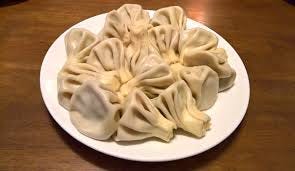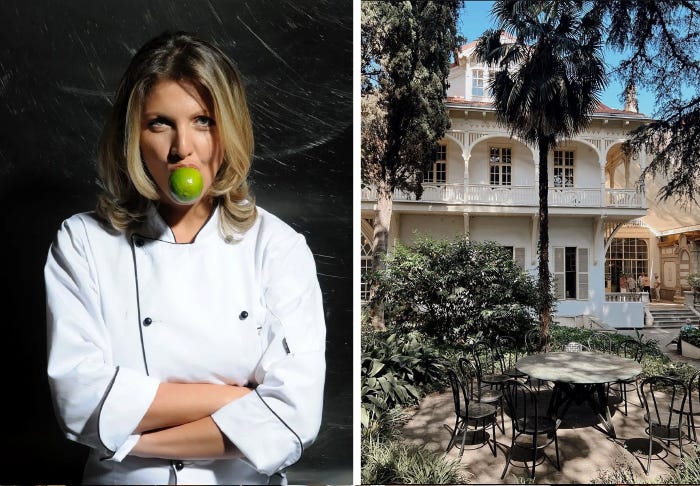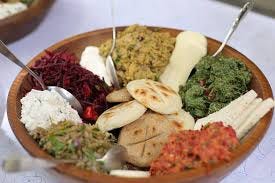Goliath and David: Putin versus the ex-USSR. Weaponry? Food.
A recipe for Georgian eggplant-and-crushed walnut rolls (nigvziani badrijani)
The only Moscow correspondent during Gorbachev’s Glasnost and Perestroika years allowed to be the driver of their own car, I was free to screech to a halt between interviews and briefings wherever I saw a promising queue in the deprived Soviet capital. There was the abiding hope that people were in line for some food more interesting than the scant supplies available at shops called ‘Meat’, ‘Vegetables-Fruit’, or ‘Bread’. Only once you reached the goal did you sometimes discover the treasure was a massive, shiny faux-satin bra constructed on engineering principles. But sometimes it was incongruous luxuries - endives, or quails’ eggs, or, one time, defrosting lobster flown in from Havana.
I hadn’t lived there long before I understood how lucky I was to have this freedom. Other correspondents were obliged to be driven about by ‘shaffures’ foisted upon them by the Foreign Ministry to restrict their freedom of movement. So I began what I’ve been told may well have been the first-ever newsletter, ‘Capital Gains - Making the Most of Moscow’. A Roneo-ed sheet distributed among the foreign community by the American Embassy, it revealed where such rarities might be found, and how to cook unfamiliar ingredients.
One day, the embassy telephoned to say they had been asked by the wife of Eduard Shevardnadze, the Minister of Foreign Affairs, both Georgians, if the Kremlin wives could be added to the distribution list. Streuth, I thought. If the Politburo doesn’t know where to find food, we really are up the creek. A year later, an invitation came from Mrs Shevardnadze to join her and the wives of ten foreign ambassadors on a private tour of Georgia as a ‘thank you’.
Where Russia was grey, Georgia was in technicolour. Georgians made eye contact, and smiled. Tbilisi’s markets were as filled with fresh farmers’ produce as the shops of Moscow were entirely devoid of them. Gleaming tomatoes were piled high next to shining aubergines. Mounds of fruits and delicate herbs covered tables next to young garlic, fresh greens and all manner of just-picked vegetables, glories unseen in the Soviet capital. We were taken to restaurants and exposed to traditional dishes filled with flavour a far cry from the dreary cabbage stews of Moscow. And dumplings: how could a Russian pierogi possibly be compared to a Georgian khinkali and think to come out ahead?
“Where can I buy a bottle of your red in Moscow?” I asked the owner of a winery. He looked at me as though I were mad. “Whyever would I send it to Moscow?” In an admirable show of defiance, at the railway station courageous announcements over the tannoy were made of the departure of trains “to the Soviet Union”, as though Georgia weren’t an involuntary part of it.
Destination countries of South East Asia are populated by tourists who, as Kate Walker writes in Around the World in 80 Scrapes, believe “it is the responsibility of other cultures to preserve themselves in aspic so that visitors can enjoy the spectacle of lives lived differently.” I know how lucky I am to have backpacked around the world before it became pockmarked with Western hotel chains and franchised restaurants, and am sad to see neon signage flashing across what were once modest Vietnamese fishing ports. But her point is correct: tourists have no right to expect local residents to preserve traditions for our privileged pleasure, reducing them to a form of entertainment.
Georgia is protected from the hordes of hen and stag parties which climb onto cheap carriers to create disrespectful havoc across European and Far East destinations by the fact that it is a challenge to get to. An endless flight is broken by an hours-long airport transfer and hideously early morning departure and arrival. But once in Tbilisi, Georgian culture makes the discomfort more than worthwhile. This is the land, after all, of Jason, his Argonauts, and the Golden Fleece. As a stop on the Silk Road, the nation has been influenced by traders from Persia, Mongolia, China, and Turkey, some of whose rulers took Georgia over. Since independence, it has become a destination for tourists in search of a country with a unique culture and history that hasn’t abandoned its heritage. Yet to its food traditions, a spirited handful of its chefs have applied tweaks and interpretations that make its classic dishes contemporary but not unrecognisable, even to Georgian food purists.
The tourists Georgia is not protected from are the Russians escaping call-up to the war against Ukraine who have flooded the country in their thousands, a soft invasion paying over-the-odds in apartment rents and buying up local businesses to support their determination not to be drafted and so pricing locals out of the market. Brave restaurants post signs saying Russian diners are unwelcome.
I returned to Georgia again about 15 years ago, and have come back several times since, this week for Zeg, a glittering story-telling (in its widest sense) conference in Tbilisi. I’ll be moderating a discussion between two Georgian chefs who have been radically redefining the nation’s cuisine in the aftermath of: annexation (by Russia in the 19th century); independence in 1991; the 2003 Rose Revolution, a non-violent transfer of power; war with Russia in 2008; and this May’s fierce anti-government street protests against the contentious "transparency on foreign influence" bill dubbed the "foreign agents law" and designed, its myriad opponents say, to appease Moscow and stifle dissent.
Tekuna Gachechiladze, a graduate of New York’s Culinary Institute who for twenty years has been overturning preconceptions of Georgian cuisine at Cafe Litteri and her five other Tbilisi restaurants, has been working with farmers who provide her the ingredients to revive or reinterpret lost dishes of tradition. Returning to Tbilisi in 2004, she went into Georgian historical records to uncover classic national recipes and has sensitively rebuilt or reconstructed them for a modern generation, just as she observed being done by American chefs.
Meriko Gubeladze from Shavi Lomi (Black Lion) told Georgia Today that what she is trying to do in updating classics like ghomi, Georgia’s answer to polenta, and chakapuli lamb stew, a favourite dish of Stalin, “is to bring back a lot of traditional dishes that were lost during communist times. By ‘lost’, I mean that people stopped cooking them as the culture of borsht and cutleti took over. We lost a lot of different kinds of cheeses and grapes, amongst other things. Today, a lot of us chefs are trying to find the old recipes and bring them back into everyday life. There’s a lot of work left until we achieve collective success in this goal, but we’re definitely getting there slowly but surely.”
To discover Georgian cuisine without going there (which I urge you to do), you will need a few essential spices available from internet sources to give the dishes their distinctive flavour. Walnuts are one of its key and constant ingredients.
500g eggplants, 250g walnuts, 1 teaspoon dried Blue Fenugreek, 1 teaspoon of dried coriander, 1 teaspoon of paprika, 1 teaspoon dried marigold, 3 cloves of garlic, 3 tablespoons white wine vinegar, salt to taste, 100ml vegetable or light olive oil, 2 tablespoons roughly chopped flat leaf parsley, 4 tablespoons pomegranate seeds.
Crush the walnuts and garlic together. It is common in Georgia to further crush the nuts with the back of a spoon to extract the walnut oil. The oil is later used to dress the prepared dish. It is quite a strenuous process and we did not do it for this recipe. Add the crushed walnuts and garlic to a mixing bowl and add the spices, salt, vinegar and 3-4 tbs of water. Mix thoroughly. Slice each eggplant length ways into 4 or 5 pieces. Add oil to a pan and fry the eggplant on a medium heat until cooked on both sides. Remove eggplant from the pan and use kitchen paper to absorb excess oil. Spread the walnut mixture onto each slice of eggplant. Fold the eggplant slice in half over itself. Spread more walnut mixture onto the top of each folded eggplant. Spread more walnut mixture onto the top of each folded eggplant. Scatter over parsley leaves and pomegranate seeds.












So jealous you're there for Zeg! I did a quick visit last month and as always had a thoroughly delicious and delightful time. Enjoy!!
Great stories, Julia! Thank you!!